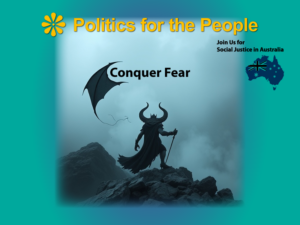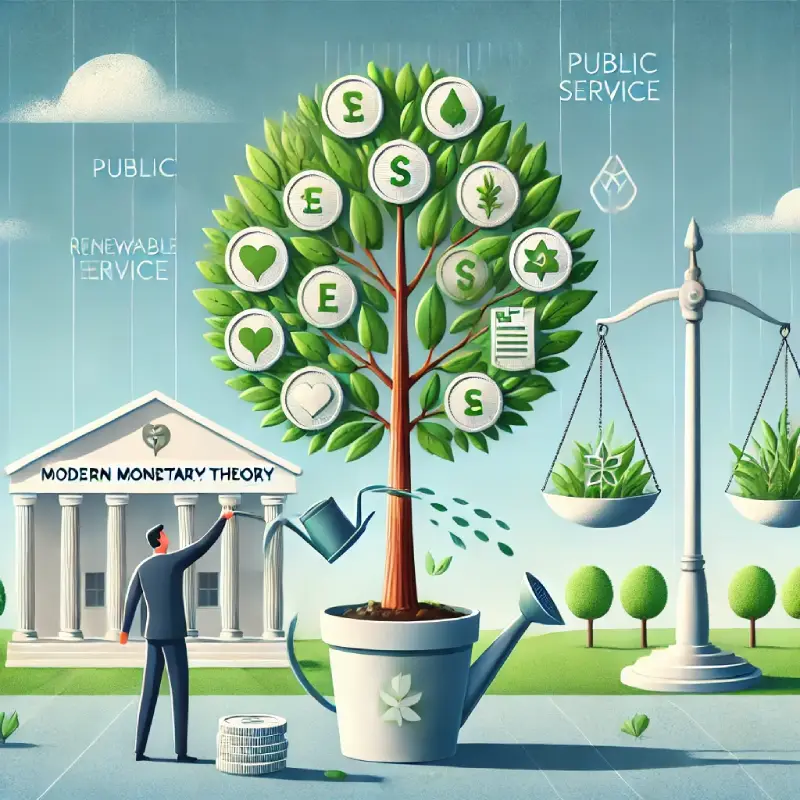Description
Discover how Modern Monetary Theory (MMT) challenges neoliberal norms and offers solutions to economic inequality and climate change.
Introduction
Modern Monetary Theory has sparked both hope and controversy. Advocates argue that MMT can fund ambitious public projects without the traditional fear of national debt. However, mainstream economists and political elites often dismiss MMT, clinging to outdated fiscal norms. But why does this resistance exist, and how can MMT improve lives and protect the planet?
This article explores these questions, shedding light on how MMT differs from the neoliberal economic framework and its potential to create a fairer, more sustainable society.
Understanding Modern Monetary Theory
What Is MMT?
Modern Monetary Theory explains that governments with sovereign currencies, such as the Australian dollar, cannot “run out of money” as households or businesses can. These governments can issue currency to fund essential public services and projects.
Key Principles of MMT:
1. Government Spending Isn’t Like Household Spending: Governments can create money, but households cannot.
2. Inflation Is the Real Constraint: The limit to government spending is inflation, not money scarcity.
3. Taxes Do Not Fund Spending: Taxes are primarily a tool to manage inflation and redistribute wealth rather than finance public services.
Why Mainstream Economists Resist MMT
Attachment to Old Economic Ideas

Mainstream economics views government budgets like household budgets. This misconception reinforces fear around national debt and deficits. The belief that balanced budgets signify economic responsibility is deeply ingrained.
Influence of Financial Institutions
Financial institutions like banks thrive when individuals rely on education, housing, and healthcare loans. MMT challenges this model by advocating for direct government funding of essential services, which could reduce the need for private loans.
Misunderstanding Deficits
Deficits are often portrayed as reckless overspending. However, MMT reframes deficits as investments that create public surpluses. For instance, government spending on public hospitals leads to a healthier, more productive society.
Example: In 2020, the Australian government spent billions during the COVID-19 crisis, proving that deficit spending can provide economic stability during crises.
Myths About MMT That Hinder Its Acceptance
Myth 1: Deficits Cause National Bankruptcy
Reality: A country with its currency cannot go bankrupt like individuals or businesses. It can always issue more money but must balance this with inflation control.
Myth 2: Government Spending Always Causes Inflation
Reality: Inflation occurs when demand exceeds the economy’s ability to supply goods and services. MMT proposes that government spending be aligned with available resources to avoid inflation.
How MMT Benefits Ordinary Citizens and the Environment
Full Employment and Job Guarantees
MMT prioritizes full employment through federally funded job guarantee programs. These programs provide jobs for anyone willing and able to work at a living wage.
Example: A job guarantee program could focus on green infrastructure, aged care, and community services, addressing unemployment and environmental challenges.
Economic Stability Without Austerity
Unlike neoliberal policies that cut public spending during recessions, MMT supports increased public investment during economic downturns to support stability.
Current Approach: Neoliberal frameworks often lead to austerity during financial crises, cutting essential services and deepening inequality.
MMT Approach: Increased government spending prevents mass unemployment and sustains essential services during economic shocks.
Tackling the Climate Crisis
MMT enables governments to fund large-scale environmental initiatives without being constrained by fears of debt.
Example: Australia could fund renewable energy projects, climate-resilient infrastructure, and sustainable public transport.
Key Point: The real constraint is resource availability, not funding. MMT can create jobs and reduce emissions by directing investments toward sustainable projects.
Comparing Modern Monetary Theory and Neoliberal Approaches
Neoliberal Approach

• Prioritizes balanced budgets and low government spending.
• Relies on privatization and corporate tax cuts to stimulate growth.
• Consequences: Rising inequality, environmental degradation, and underfunded public services.
MMT Approach

• Focuses on full employment and public investment.
• Sees deficits as investments in society rather than liabilities.
• Benefits: Stronger public health, education, and climate resilience.
Addressing Concerns About Inflation
MMT acknowledges that inflation is a key risk of unchecked government spending but proposes practical solutions:
1. Monitoring Resources: Governments must assess resource availability, such as housing and energy, to prevent supply shortages.
2. Smart Taxation: Taxes can reduce excess demand and extraordinary overheated sectors (e.g., luxury housing markets).
3. Targeted Spending: Investment should be directed toward areas with underutilized resources, such as renewable energy and public transport.
Example: Implementing taxes on speculative real estate purchases could curb inflation while ensuring affordable housing.
The Political Resistance to MMT
Fear of Market Reactions
Politicians often fear increased government spending will lead to adverse market reactions, such as currency depreciation, higher bond yields, and capital flight.
These concerns stem from the belief that financial markets will “discipline” governments by causing their currency to lose value if they run large deficits.
However, MMT argues that such fears are exaggerated and often based on outdated economic theories:
Historical Context: Countries with sovereign currencies, like Australia, have weathered currency fluctuations without economic collapse. The Australian dollar’s value has fluctuated without derailing public spending policies.
Currency Sovereignty: Governments that issue their currency control their monetary policy. While exchange rates may fluctuate, a nation with currency sovereignty can still meet domestic obligations regardless of international currency shifts.
Short-Term vs Long-Term Views: Market reactions can cause short-term volatility, but substantial public investment can lead to long-term economic stability, growth, and improved investor confidence.
MMT’s Focus: Domestic Resource Management
MMT emphasizes that economic policies, such as skilled labour, infrastructure, and renewable energy projects, should ensure the use of productive resources within the country.
Instead of catering to market speculators, policymakers should prioritize public needs and sustainable growth.
Example: Despite fears, countries like Japan have maintained high public debt levels relative to GDP without experiencing catastrophic market reactions due to their currency sovereignty.
Resistance from Powerful Interests
Wealthy elites and corporations benefit from the status quo. MMT’s emphasis on public investment threatens its influence.
Key Point: Neoliberal policies often prioritize corporate tax cuts and subsidies while underfunding public services.
A Practical Vision for Australia’s Future Under MMT
Education
• Free, world-class education funded without student debt.
• Investment in public schools and universities to ensure equal and free access.
Healthcare
• Fully funded universal healthcare that ends out-of-pocket costs.
• Expanding public healthcare services to rural and remote areas.
Housing
• Direct government-funded housing programs to provide affordable homes.
• Prioritizing public housing construction to reduce homelessness.
Environment
• Large-scale funding for renewable energy and climate resilience projects.
• Transitioning from fossil fuels to sustainable energy sources.
Conclusion
Modern Monetary Theory (MMT) offers a new way of thinking about public spending. MMT empowers governments to address economic inequality and environmental degradation without fearing deficits by viewing money as a public resource, not a finite asset. The proper focus should be achieving employment, reducing inequality, and combating the climate crisis.
Call to Action
Do you see opportunities for community-driven change in Australia’s dollar sovereignty?
If you found this article insightful, explore more about political reform and Australia’s monetary sovereignty on Social Justice Australia: https://socialjusticeaustralia.com.au/
Share this article with your community to help drive the conversation toward a more just and equal society.
Click on our “Reader Feedback” menu. Let us know how our content has inspired you. Submit your testimonial and help shape the conversation today!
Additionally, leave a comment about this article below.
Q&A Section
Q: Doesn’t government spending always lead to inflation?
A: No, inflation occurs when demand exceeds the economy’s ability to produce goods and services. MMT advocates for balanced spending that matches available resources.
Q: Why can’t governments print unlimited money?
A: Governments can issue money but must ensure spending doesn’t outpace resource availability. Inflation is the limit, not money scarcity.
Q: How does MMT propose funding green infrastructure?
A: MMT enables governments to distribute resources directly to climate initiatives by creating public investment without relying on debt markets.
Support Our Mission
If you believe in holding corporations accountable and creating a more just society, consider supporting our work. Your donations help us continue producing in-depth, informative content and advocating for meaningful reforms. Every contribution, big or small, makes a difference.
Donate Here to help drive positive change.
Thank you for standing with us for a fairer, more equitable Australia.

